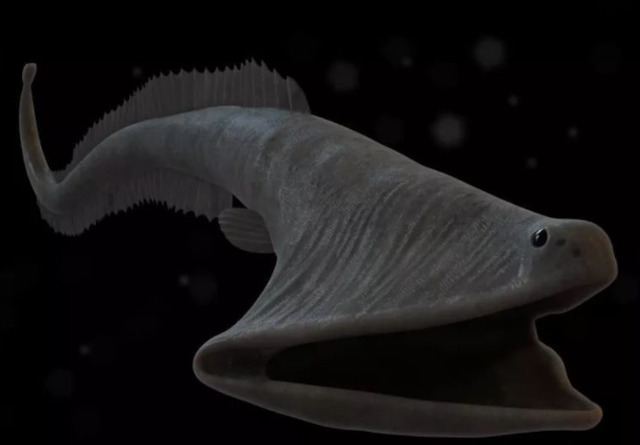Swallowing eel (scientific name: Eurypharynx pelecanoides), also known as wide-throated eel, swallowing eel, pharyngeal sac eel, big-mouthed eel, broad-mouthed eel, giant-mouthed eel, etc,The world of eels is as fascinating as it is mysterious, and few species embody this more than the swallowing eel (also known as the gulping eel or serpent eel). With a terrifying appearance and ruthless predatory behavior, this eel is both feared and admired. From its haunting physical features to its unique role in cuisine and its conservation challenges, the swallowing eel remains an intriguing subject of study. In this comprehensive guide, we will explore the eerie nature of the swallowing eel, its habitat, behavior, and culinary significance, as well as the pressing conservation issues it faces.
Swallowing eels are incredibly adaptable and can be found in a variety of environments, from coastal waters to estuaries and freshwater rivers. These eels are highly skilled at camouflaging within their surroundings, thriving in environments where they can easily remain hidden.

Coastal Waters: Swallowing eels prefer sandy or muddy bottoms where they can burrow and blend in.
Estuaries: These brackish water areas serve as both feeding and breeding grounds.
Freshwater Bodies: Certain species migrate to freshwater environments, especially during spawning seasons.
Their adaptability to both saltwater and freshwater environments, coupled with their secretive nature, makes them particularly elusive and difficult to study in detail.
The most striking aspect of the swallowing eel is its horrifying physical appearance. Often described as snake-like, these eels can grow to impressive lengths. Their body is typically slim and muscular, covered in a slick, dark skin that ranges from muddy brown to deep olive green—perfect for blending into their murky underwater habitats. However, it’s their wide, gaping jaws that truly terrify. Equipped with rows of needle-like teeth, these eels can swallow prey whole, and their enormous mouths are capable of expanding to accommodate creatures much larger than themselves.
Serpentine Body: The long, slender body gives the eel an eerie, snake-like presence as it glides through the water.
Gaping Jaws: The large, flexible mouth is a hallmark of the species, designed for swallowing prey whole in one swift movement.
Glowing Eyes: Their eyes, which can appear to glow in low light, add to their ghostly and unsettling appearance.
Camouflage: Their skin color helps them hide in the shadows of the ocean floor, enhancing their predatory success.
The swallowing eel’s behavior is just as fearsome as its appearance. These eels are primarily nocturnal hunters, emerging under the cover of night to stalk and capture their prey. They are ruthless ambush predators, lurking in the shadows of the seabed, waiting for the perfect moment to strike. Their hunting style is one of patience and sudden, brutal action.
Ambush Predator: The eel lies in wait, often buried in the sand or mud, striking with lightning speed when prey comes close.
Swallowing Whole: Thanks to their enormous jaws and flexible body, swallowing eels can devour prey much larger than themselves.
Burrowing: Some species are known to burrow into the sea floor, positioning themselves to leap out at passing prey.
This ambush predation, combined with their ability to consume creatures whole, makes the swallowing eel a formidable and terrifying predator in its environment.

While their appearance and behavior might evoke fear, swallowing eels are considered a delicacy in many parts of the world. Their rich, savory flavor and unique texture make them a sought-after ingredient in a variety of cuisines. However, their menacing look may make some diners hesitant to try them, but for those willing to venture into the world of eel cuisine, the experience is unforgettable.
Grilled Eel (Unagi): A staple in Japanese cuisine, grilled eel is typically glazed with a sweet soy-based sauce, highlighting the eel’s rich and buttery flavor.
Eel Sushi: Popular in Japan, eel is often served as part of sushi, adding a unique, savory taste to the dish.
Eel Soup: In some cultures, eel soup is a traditional dish, believed to have numerous health benefits and often enjoyed during colder months.
Swallowing eel’s culinary popularity contrasts sharply with its fearsome reputation, demonstrating its versatility both in nature and at the dinner table.
Despite their widespread presence in different aquatic habitats, swallowing eels face several threats that endanger their populations. Overfishing, habitat destruction, and climate change are the main culprits behind the decline in their numbers. In some regions, eels are considered a delicacy, leading to unsustainable fishing practices that put significant pressure on their populations.
Habitat Loss: Human activities such as coastal development, pollution, and dam construction disrupt the natural habitats of swallowing eels.
Overfishing: The demand for eel in culinary markets has led to overfishing in many areas, further endangering their populations.
Climate Change: Changing water temperatures and ocean acidification threaten the habitats and breeding grounds of eels.
Sustainable Fishing Practices: Promoting sustainable eel fishing can help protect their populations for future generations.
Habitat Preservation: Protecting critical habitats, such as estuaries and freshwater breeding grounds, is key to ensuring the survival of these eels.
Conservation efforts are crucial to maintaining a balance in aquatic ecosystems, as the swallowing eel plays an important role in controlling the population of smaller marine species.

The swallowing eel is a creature of contrasts. On one hand, its terrifying appearance and ruthless hunting techniques make it one of the most fearsome predators in the aquatic world. On the other, it is a prized delicacy enjoyed by many around the globe. Its adaptability allows it to thrive in various habitats, yet it remains vulnerable to human activities. Understanding the complex nature of the swallowing eel—from its eerie physical traits to its role in cuisine and conservation—highlights the importance of preserving these enigmatic creatures for future generations.
animal tags: Swallowing-eel
We created this article in conjunction with AI technology, then made sure it was fact-checked and edited by a Animals Top editor.